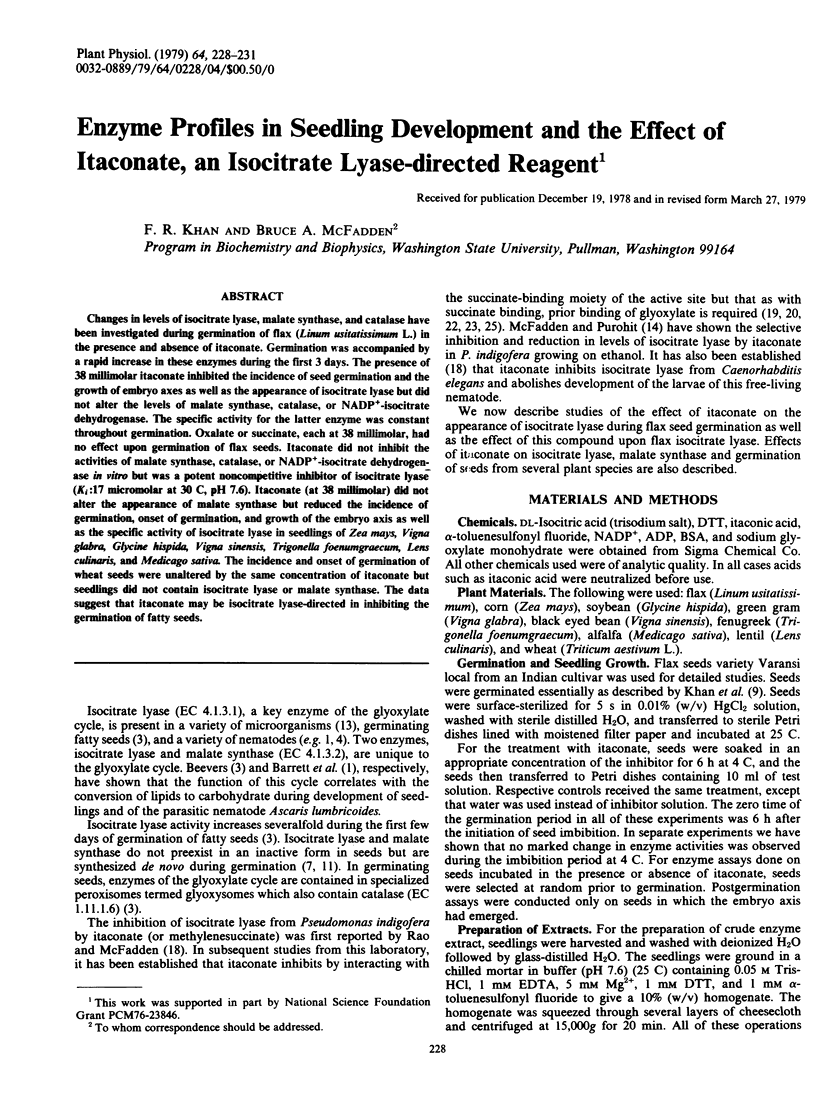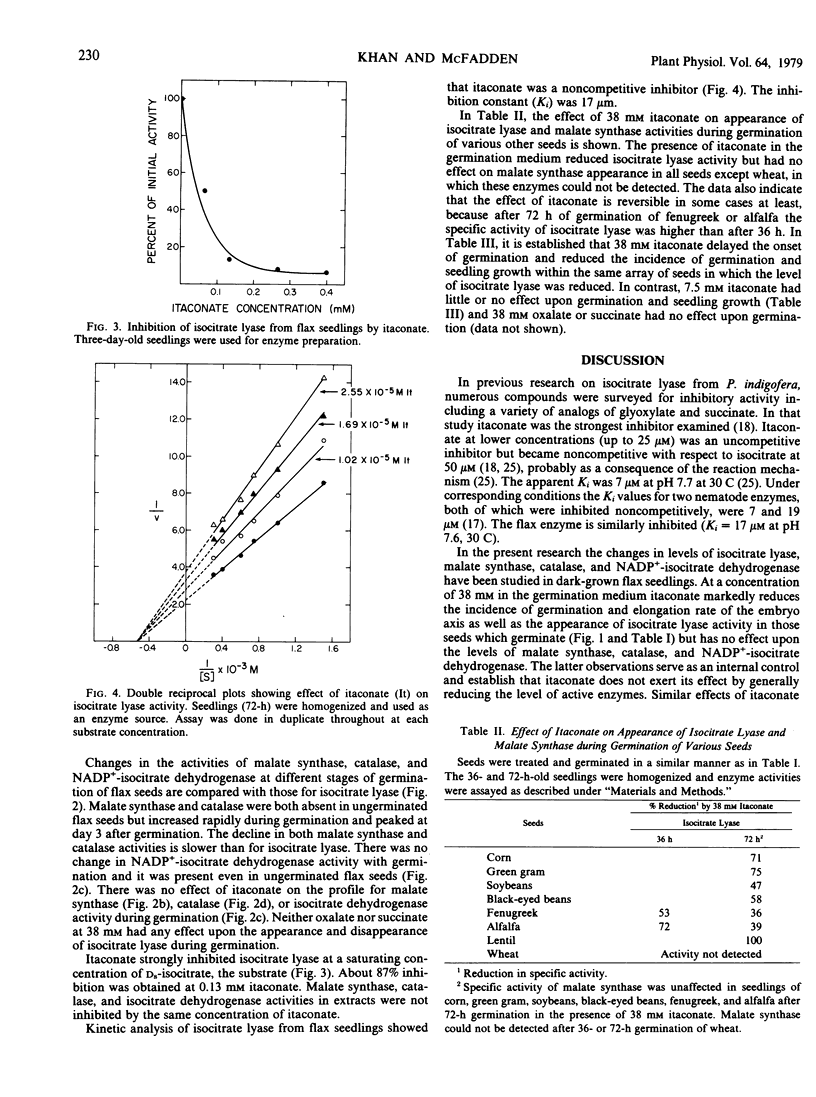Abstract
Changes in levels of isocitrate lyase, malate synthase, and catalase have been investigated during germination of flax (Linum usitatissimum L.) in the presence and absence of itaconate. Germination was accompanied by a rapid increase in these enzymes during the first 3 days. The presence of 38 millimolar itaconate inhibited the incidence of seed germination and the growth of embryo axes as well as the appearance of isocitrate lyase but did not alter the levels of malate synthase, catalase, or NADP+-isocitrate dehydrogenase. The specific activity for the latter enzyme was constant throughout germination. Oxalate or succinate, each at 38 millimolar, had no effect upon germination of flax seeds. Itaconate did not inhibit the activities of malate synthase, catalase, or NADP+-isocitrate dehydrogenase in vitro but was a potent noncompetitive inhibitor of isocitrate lyase (Ki:17 micromolar at 30 C, pH 7.6). Itaconate (at 38 millimolar) did not alter the appearance of malate synthase but reduced the incidence of germination, onset of germination, and growth of the embryo axis as well as the specific activity of isocitrate lyase in seedlings of Zea mays, Vigna glabra, Glycine hispida, Vigna sinensis, Trigonella foenumgraecum, Lens culinaris, and Medicago sativa. The incidence and onset of germination of wheat seeds were unaltered by the same concentration of itaconate but seedlings did not contain isocitrate lyase or malate synthase. The data suggest that itaconate may be isocitrate lyase-directed in inhibiting the germination of fatty seeds.
Full text
PDF



Selected References
These references are in PubMed. This may not be the complete list of references from this article.
- BEERS R. F., Jr, SIZER I. W. A spectrophotometric method for measuring the breakdown of hydrogen peroxide by catalase. J Biol Chem. 1952 Mar;195(1):133–140. [PubMed] [Google Scholar]
- Beevers H. Glyoxysomes of castor bean endosperm and their relation to gluconeogenesis. Ann N Y Acad Sci. 1969 Dec 19;168(2):313–324. doi: 10.1111/j.1749-6632.1969.tb43118.x. [DOI] [PubMed] [Google Scholar]
- Colonna W. J., McFadden B. A. Isocitrate lyase from parasitic and free-living nematodes. Arch Biochem Biophys. 1975 Oct;170(2):608–619. doi: 10.1016/0003-9861(75)90156-3. [DOI] [PubMed] [Google Scholar]
- Cooper R. A., Kornberg H. L. The utilization of itaconate by Pseudomonas sp. Biochem J. 1964 Apr;91(1):82–91. doi: 10.1042/bj0910082. [DOI] [PMC free article] [PubMed] [Google Scholar]
- Daron H. H., Rutter W. J., Cunsalus I. C. Isocitrate lyase. Kinetics and substrate-tritium exchange reactions. Biochemistry. 1966 Mar;5(3):895–903. doi: 10.1021/bi00867a013. [DOI] [PubMed] [Google Scholar]
- Gientka-Rychter A., Cherry J. H. De Novo Synthesis of Isocitritase in Peanut (Arachis hypogaea L.) Cotyledons. Plant Physiol. 1968 Apr;43(4):653–659. doi: 10.1104/pp.43.4.653. [DOI] [PMC free article] [PubMed] [Google Scholar]
- Khan F. R., Saleemuddin M., Siddiqi M., McFadden B. A. Purification and properties of isocitrate lyase from flax seedlings. Arch Biochem Biophys. 1977 Sep;183(1):13–23. doi: 10.1016/0003-9861(77)90413-1. [DOI] [PubMed] [Google Scholar]
- Kovach J. S., Phang J. M., Ference M., Goldberger R. F. Studies on repression of the histidine operon. II. The role of the first enzyme in control of the histidine system. Proc Natl Acad Sci U S A. 1969 Jun;63(2):481–488. doi: 10.1073/pnas.63.2.481. [DOI] [PMC free article] [PubMed] [Google Scholar]
- LOWRY O. H., ROSEBROUGH N. J., FARR A. L., RANDALL R. J. Protein measurement with the Folin phenol reagent. J Biol Chem. 1951 Nov;193(1):265–275. [PubMed] [Google Scholar]
- Longo C. P. Evidence for de novo synthesis of isocitratase and malate synthesis in germinating peanut cotyledons. Plant Physiol. 1968 Apr;43(4):660–664. doi: 10.1104/pp.43.4.660. [DOI] [PMC free article] [PubMed] [Google Scholar]
- McFadden B. A., Purohit S. Itaconate, an isocitrate lyase-directed inhibitor in Pseudomonas indigofera. J Bacteriol. 1977 Jul;131(1):136–144. doi: 10.1128/jb.131.1.136-144.1977. [DOI] [PMC free article] [PubMed] [Google Scholar]
- Patel T. R., McFadden B. A. Caenorhabditis elegans and Ascaris suum: inhibition of isocitrate lyase by itaconate. Exp Parasitol. 1978 Apr;44(2):262–268. doi: 10.1016/0014-4894(78)90107-8. [DOI] [PubMed] [Google Scholar]
- Rao G. R., McFadden B. A. Isocitrate lyase from Pseudomonas indigofera. IV. Specificity and inhibition. Arch Biochem Biophys. 1965 Nov;112(2):294–303. doi: 10.1016/0003-9861(65)90049-4. [DOI] [PubMed] [Google Scholar]
- Rittenhouse J. W., McFadden B. A. Inhibition of isocitrate lyase from Pseudomonas indigofera by itaconate. Arch Biochem Biophys. 1974 Jul;163(1):79–86. doi: 10.1016/0003-9861(74)90456-1. [DOI] [PubMed] [Google Scholar]
- Roche T. E., McFadden B. A. Active site modification of isocitrate lyase. Biochem Biophys Res Commun. 1969 Oct 8;37(2):239–246. doi: 10.1016/0006-291x(69)90725-6. [DOI] [PubMed] [Google Scholar]
- Roche T. E., McFadden B. A., Williams J. O. Modification of the active site of isocitrate lyase from Pseudomonas indigofera. Arch Biochem Biophys. 1971 Nov;147(1):192–200. doi: 10.1016/0003-9861(71)90327-4. [DOI] [PubMed] [Google Scholar]
- Roche T. E., Williams J. O., McFadden B. A. Effect of pH and buffer upon Km and inhibition by phosphoenolpyruvate of isocitrate lyase from Pseudomonas indigofera. Biochim Biophys Acta. 1970 Apr 22;206(1):193–195. doi: 10.1016/0005-2744(70)90100-2. [DOI] [PubMed] [Google Scholar]
- Rogers J. E., McFadden B. A. Isocitrate lyase from Pseudomonas indigofera: pH dependence of catalysis and binding of substrates and inhibitors. Arch Biochem Biophys. 1976 Jun;174(2):695–704. doi: 10.1016/0003-9861(76)90400-8. [DOI] [PubMed] [Google Scholar]
- WANG S. F., ADLER J., LARDY H. A. The pathway of itaconate metabolism by liver mitochondria. J Biol Chem. 1961 Jan;236:26–30. [PubMed] [Google Scholar]
- Williams J. O., Roche T. E., McFadden B. A. Mechanism of action of isocitrate lyase from Pseudomonas indigofera. Biochemistry. 1971 Apr 13;10(8):1384–1390. doi: 10.1021/bi00784a017. [DOI] [PubMed] [Google Scholar]


